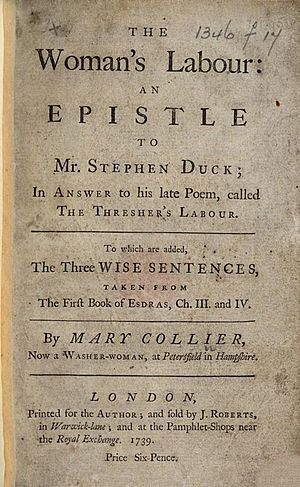Mary Collier facts for kids
Quick facts for kids
Mary Collier
|
|
|---|---|

Title page of Mary Collier's The Woman's Labour: an Epistle to Mr Stephen Duck (London, 1739)
|
|
| Born | 1688-10-09 West Sussex |
| Died | 1762-10-20 |
| Resting place | Alton, Hampshire |
| Occupation | Washer-woman |
| Language | English |
| Nationality | English |
| Notable work | The Woman's Labour (1739) |
|
|
|
Mary Collier (born around 1688 – died 1762) was an English poet. She is best known for her poem The Woman's Labour. This poem describes the hard work of women. It also shares a strong message about fairness.
A Poet's Life
We don't know much about Mary Collier's early life. Most of what we know comes from her own writings. She was born in Midhurst or Lodsworth, West Sussex, England. Her parents were poor. She learned to read and write at home.
Mary worked many different jobs to support herself. She was a washer-woman, a brewer, and did other types of work. In the 1720s, she moved to Hampshire to find more jobs.
At first, Mary wrote poems just for fun. She would read them aloud to entertain people. This helped others discover her talent. A family she worked for even encouraged her to publish her poems. Mary didn't have any children to support. This meant she could write with a strong and honest voice.
Her Famous Poems
Mary Collier was very upset when she read a poem called The Thresher's Labour by Stephen Duck in 1730. She felt he didn't respect working-class women. So, she wrote her most famous poem, The Woman's Labour: an Epistle to Mr Stephen Duck. This poem is 246 lines long.
In her poem, Mary listed all the daily tasks of a working woman. This included jobs outside the home. It also included chores inside the home at the end of the day. She wrote:
-
- You sup, and go to Bed without delay,
- And rest yourselves till the ensuing Day;
- While we, alas! but little Sleep can have...
Another poem, The Three Sentences, was printed with her famous letter to Mr. Duck. This poem retells a story from an old book called 1 Esdras.
Mary Collier is an important figure among poets who taught themselves. These poets came from working-class backgrounds in the 1700s. Other poets like her included Stephen Duck, Ann Yearsley, and Mary Leapor. These poets often wrote about the changes happening in the countryside. For example, land was being fenced off, which led to many people losing their jobs.
Stephen Duck had described women laborers as lazy. This made Mary Collier very angry. At that time, women often lost jobs to men in the countryside.
Mary Collier did not earn much money from her poetry. She worked as a washer-woman until she was sixty-three years old. She kept working at other jobs for seven more years. When she was seventy, she retired due to poor health. She died two years later in Alton.
Published Works
- The Woman's Labour: an Epistle to Mr Stephen Duck (1739)
- Poems, on several occasions, by Mary Collier, Author Of The Washerwoman's Labour, With some remarks on her life (1762)
- The First and Second Chapters of the First Book of Samuel Versified (1762)
- The Poems of Mary Collier (1765)
See also
- List of 18th-century British working-class writers
Online Versions of Her Work
- The Woman's Labour: an Epistle to Mr Stephen Duck (1739) (Google Books) (Internet Archive)
- Poems, on several occasions, by Mary Collier, Author Of The Washerwoman's Labour, With some remarks on her life (1762) (Google Books)

